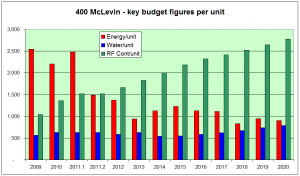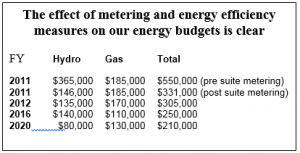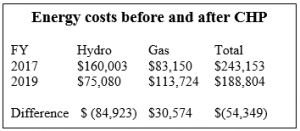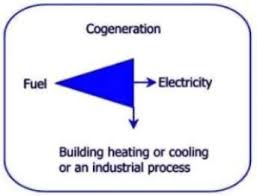 June 2020
June 2020
Editor’s Note
This article documents how one building achieved substantial energy savings over a nine-year period. They directed savings to what was an inadequate reserve fund rather than increase condo fees or implement a special assessment.
Nine years ago, our 222-unit condo high-rise was in trouble. Electricity expense was budgeted at $365,000 and gas at $185,000. In total this represented 59 percent of operating expenses. Maintenance fees had jumped 28 percent over 25 months and reserve fund contributions were just $337,000, or 23 percent of budget.
Today, after steep price increases, our electricity budget is down to $80,000; gas is at $130,000. Energy costs have fallen to 21 percent of operating expenses. Money liberated by reducing energy costs has boosted reserve fund contributions by $280,000 a year to $617,000, or 38 percent of the budget.

400 McLevin was built in 1991 and celebrates its 29th year in 2020.
 Nine years ago, our community began focusing on reducing energy consumption. Measures were implemented over this period in three stages which have contributed to our dramatic turnaround:
Nine years ago, our community began focusing on reducing energy consumption. Measures were implemented over this period in three stages which have contributed to our dramatic turnaround:
- Suite metering to focus resident attention on consumption within their control;
- Building Automation System setpoints reviewed and adjusted;
- Baseboard heaters removed from locker rooms;
- Energy-efficient heat pumps installed for amenity rooms;
- Common area lighting switched to LED;
- Energy-efficient booster pumps installed;
- Variable frequency drives added to mechanical equipment;
- On-site generation of electricity and heat.
Stage 1 – Electricity Metering
The first step was to implement an electricity metering system through Toronto Hydro. This crucial and successful initial effort immediately reduced the electric budget by 60 percent. Ensuring each owner could see their personal energy consumption provided motivation to reduce both use and their cost. Owners choosing to use electricity wastefully were no longer subsidized by those choosing to conserve. Meters were installed at each panel of the common elements allowing the corporation to monitor where electricity was being used.
Stage 2 – Electricity Conservation Measures
 Internal measures ensured electricity use and cost continued to decline in subsequent years. Payback of initial investments was always less than two years.
Internal measures ensured electricity use and cost continued to decline in subsequent years. Payback of initial investments was always less than two years.
Stage 3 – Displacement of Purchased Electricity using Combined Heat and Power (CHP) System
Since 2018 we have achieved even greater efficiencies and savings from technology seldom used in condo buildings – Combined Heat and Power, also referred to as CHP or co-generation. We invested a total of $400,000 in CHP, after taking advantage of incentives available at the time. Estimated payback is about eight years based on current cost of electricity – likely less considering anticipated future cost increases.
Co-generation is not new “bleeding-edge” technology – it has been widely used for decades in hospitals, factories, hotels and recreation centres where there is a need for both power and heat. Co-generation refers to simultaneous production of electric power and heat. With co-generation, heat is not a wasted by-product of electric power. It is reused to keep a building warm during cold months or to provide hot water without purchasing external power. Electricity created by the system can be used in place of purchased electricity to power elevators and other equipment. Reducing purchased electricity also reduces the peak demand charge which forms part of our common element hydro bill. With some systems electricity can be purchased during off-peak hours at lower cost.
In 2018 we started using a Capstone microturbine in our mechanical room – a machine about the size of two refrigerators. Essentially a small jet engine, it is quiet, vibration-free, has only one moving part, and requires very low maintenance. This supplies over half our common-element electricity and meets almost all our year-round domestic hot water needs. Our electric bill has dropped by about $85K while our gas bill has increased by $31K.
The system takes most of the heating load away from boilers and, with increased capacity, will replace the emergency generator, allowing for continuous occupation during extended power failures.

Stage 4 – Future Enhancements to CHP
A further step we are considering is moving from co-generation to tri-generation. This entails adding another turbine and an absorption chiller for chilling water used to cool the building during summer. Conventional electric chillers in high-rise buildings are typically oversized and operate at low efficiency, thus accounting for a large portion of the total electric bill. Absorption chillers run on heat and do not require power. A second turbine, combined with an absorption chiller, will ensure we meet the electrical needs of the common elements while fully utilizing heat produced year-round.
Some energy resellers offer to install, own and maintain CHP equipment at no cost to the condominium corporation. Our corporation chose to purchase equipment rather than share savings with a reseller.
Zahir Antia is a Condo Director and Secretary of MTCC 971. He can be reached at bod.mtcc971@gmail.com .







